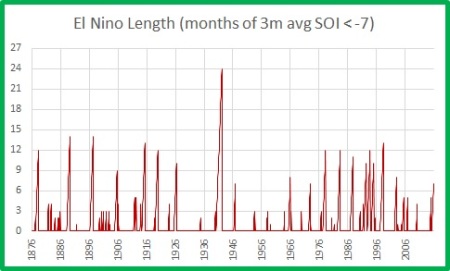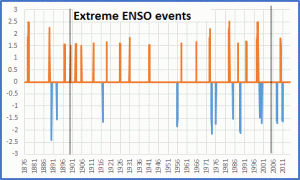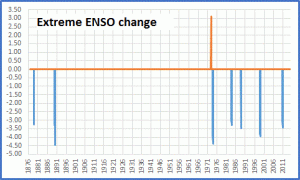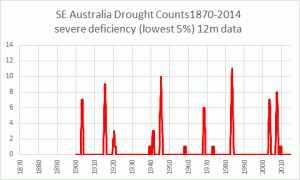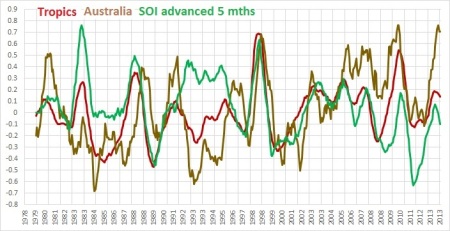The answer, my friend, is blowin’ in the wind…. literally.
In brief…
- At Sydney, the long term sea level rise is about 1 mm per year, with short periods of rapid increase and a long plateau of very small or zero trend in the second half of last century. As Australia is geologically stable, it is likely that a similar pattern occurred all around the coast.
- This gradual sea level rise is consistent with oceanic warming since the Little Ice Age, with fluctuations resulting from El Nino-Southern Oscillation (ENSO) changes.
- Tide gauge data since 1990 from different locations show rises varying from 2.4 mm to 7.2 mm per year. A significant proportion of this is due to ENSO wind circulation changes.
- There is no sign of any unusual acceleration in Australian tide gauge data.
The Bureau of Meteorology maintains the Australian Baseline Sea Level Monitoring Project, with a number of tide gauges around the coastline, shown here:
Fig. 1: Australian Baseline Sea Level Monitoring Project

These sites have monthly data only from 1990, mostly later, and two (Thursday Island and Port Stanvac) have very limited data and were not used in this study. I have used data for Mean Sea Level for all sites on the Australian coastline to find the current situation with sea level rise, and use the much longer dataset from Fort Denison in Sydney Harbour as well for a longer term perspective. Figure 2 is a plot of all monthly data from all sites.
Fig. 2: Australian Mean Sea Levels

Points to note:
- The mean is a measure of central tendency: the full tidal range is at least twice the values shown for each site. Broome’s range is well over 11 metres. Portland has a very small range.
- An Australian average of these means is meaningless.
- Each site has a seasonal signal which is not regular.
- It is difficult to make any meaningful comparison.
However if we look at sites individually, we can at least compare any trends. Figures 3 and 4 show MSL at sites with the greatest and least trends.
Fig. 3: MSL at Hillarys

Fig. 4: MSL at Stony Point

According to this very short record, the rate of Australian sea level rise varies in different locations, from a low of 2.4 mm per year in Bass Strait to 7.2 mm per year at Hillarys in Western Australia. Why is this?
Australia is very stable geologically, and these tide gauges are carefully checked with levelling connections between them and Global Navigation Satellite System (GNSS) sites maintained by State land and survey departments. Therefore differing rates of land movement are unlikely to be responsible.
We need to compare all sites, and as well remove the seasonal signal. To do this I calculate monthly anomalies for each site, then plot the results in Figure 5.
Fig. 5: Monthly anomalies for all Australian sites:

With the seasonal signal removed, the data show some roughly similar patterns for all sites. I now plot the mean of these anomalies, to find an “average” Australian sea level trend.
Fig. 6: Average of all MSL anomalies

All sites show marked dips in 1997-98 and 2015-16, clearly shown in the average. The influence of El Nino perhaps? Figure 7 shows the mean of all MSL anomalies with the scaled Southern Oscillation Index (SOI).
Fig. 7: Average of all MSL anomalies and SOI/200

My first response was “Wow!” Next, sea level plotted against SOI:
Fig. 8: MSL as a function of SOI

For every one point increase in the SOI, Australian sea level rises an average of 3.2 mm, and SOI change can account for more than a third of sea level rise. Now we check how the SOI has behaved over the last 27 years.
Fig. 9: Trend in SOI, 1991-2018

In this short record, the SOI has increased by about 8 points.
From this, we can deduce that a portion of the perceived sea level rise since 1991 is due to the influence of the El Nino- Southern Oscillation (ENSO), of which SOI is a strong indicator.
What mechanism could there be for this? The SOI is calculated from the difference in atmospheric pressure between Tahiti and Darwin. Darwin’s sea level is compared with the SOI in Figure 10.
Fig. 10: Darwin MSL anomalies and SOI/100

The match is very close, as the plot of MSL vs SOI shows:
Fig. 11: Darwin MSL as a function of SOI

SOI has about twice the effect on MSL at Darwin as it has on the Australian average, and more than half sea level rise can be accounted for by change in SOI. Here’s my explanation:
During La Nina, when SOI is high, the northwest monsoon is strengthened, the monsoon trough penetrates further into northern Australia in summer with lower atmospheric pressure and stronger northwest winds. This combination pushes the sea up against the northwest coast, raising the sea level. In winter, the monsoon disappears and winds are predominantly from the east. During El Nino, the monsoon is weakened and may fail completely. Thus northwest winds are weaker and the sea level is markedly lower.
That’s all very well for Darwin and other sites in northern Australia, but take a look at Figure 12, which compares seal level at Darwin with Spring Bay, in southern Tasmania, and about as far from Darwin as you can get without a passport.
Fig. 12: MSL at Darwin and Spring Bay

Note that in some (but not all) El Ninos (marked) Spring Bay sea level is also strongly affected. Note also that sea level at Spring Bay appears to start rising again several months before Darwin, in other words before the SOI starts rising.
The 2015-16 comparison of anomalies shows the Spring Bay sea level at its lowest in September 2015, rising strongly and four months before Darwin’s.
Fig. 13: MSL at Darwin and Spring Bay 2015-16

To understand this we need to consider circulation patterns as they change through the year and with ENSO events, and their effect on local sea levels. The following plots show the absolute 2015-2016 monthly mean sea levels and the long term average for each month.
Fig. 14: MSL at Darwin 2015-16 compared with average monthly levels

Darwin’s long term average sea level is highest at the peak of the Wet season (February – March) and lowest in the Dry (July – August). In 2015, the high was reached in January and the low in July- both one month earlier- and the 2016 high was in March- one month later. Below normal sea levels lasted from April 2015 to April 2016.
In contrast, Spring Bay’s average sea level is highest in the southern wet season (Winter-July) and lowest in the summer dry season (November to February). In 2015 the high was reached in May and the low in September, and the 2016 high in May.
Fig. 15: MSL at Spring Bay 2015-16 compared with average monthly levels

This happens at other sites in the southeast of Australia (from Portland to Port Kembla including Tasmania).
Fig. 16: Australian sea level at sites in the north and southeast.

Note that the same pattern applies: sea level is lower in strong El Ninos and rises before the north (in 1997-98 and 2015-16 but not so clearly in 2006-07).
A possible explanation is that circulation changes associated with the ENSO are not restricted to the tropics, although that is where the effects are largest and most visible. In normal (non-El Nino) years, the sub-tropical ridge moves north over the continent in winter, and the winter storms around the lows to its south bring rain and winds from the south-west quarter to the southern coast, particularly South Australia, Victoria, and Tasmania. These winds cause the sea to pile up (by a few centimetres) against the southern coast. In summer, the sub-tropical ridge moves south, rain bearing storms mostly pass to the south of the Australian region, and blocking highs in the Tasman Sea bring strong north-west winds across the south-east of Australia. This causes sea level to fall.
In a strong El Nino, these conditions occur earlier, with a rapid retreat south of the sub-tropical ridge so that winter storms with south-westerly winds are fewer and weaker and sea level is lower in winter and spring. Summer sea levels (November to January) are close to normal.
Figure 17 tests the response of sea level to barometric pressure at Spring Bay.
Fig. 17: Spring Bay MSL anomalies as a function of barometric pressure anomalies

The result is clear. More than half of sea level change is due to pressure variation, which causes winds to change.
The effect is much greater at Darwin.
Fig. 18: Darwin MSL anomalies as a function of barometric pressure anomalies

By the way, how much does increase in sea temperature affect sea level?
Fig. 19: Spring Bay MSL anomalies as a function of temperature anomalies

At Spring Bay, very little. An increase of one degree could raise sea level by 17 mm, but R-squared of 0.033 is tiny compared with 0.527 for air pressure.
Whatever causes El Nino also causes the southern seasonal weather cycle to occur earlier, and sea levels rebound several months before they do in the tropics.
What of the longer term?
The Australian Baseline Sea Level Monitoring Project data are limited to sea levels since 1990, so the record is too short to make assumptions about long term sea level rise, and certainly not about the future. There are longer datasets available however. Sydney Harbour (Fort Denison) has data from 1914.
Fig. 20: MSL anomalies at Fort Denison (Sydney)

That’s a long term sea level rise of 1 mm per year, or 104 mm in 100 years- a bit over 4 inches. Now there has been an apparent “acceleration” since 1991, matching the data at nearby Port Kembla:
Fig. 21: MSL anomalies at Fort Denison (Sydney) 1991-2018

But once again note the correspondence with the SOI:
Fig. 22: MSL anomalies and scaled SOI Sydney 1991-2018

A significant portion of the recent sea level rise at Sydney can be attributed to a short term rise in the SOI.
So is this recent rapid rise unique? By calculating the trend in sea level over 10 year periods, we can see periods when sea level rise has accelerated or slowed in the past:
Fig. 23: 10 year running trend in MSL at Sydney

The most recent rise in sea level of 7 to 8 mm per year over 10 years is less than that of the rise to 1953, when sea level rose by 10 mm per year.
If you think 10 year trends are too short, Figure 21 shows 30 year trends at Sydney:
Fig. 24: 30 year running trend in MSL at Sydney

The current 30 year trend is exactly the same as the trend to 1965: 2.4 mm per year. For the 30 year period to the mid-1990s the trend was zero.
Conclusion:
Across all tide gauges of the Australian Baseline Sea Level Monitoring Project, a significant proportion of sea level rise since 1990 is due to circulation changes associated with the El Nino- Southern Oscillation. The effect is much greater in the north and west, where sea level rise is highest, but also is evident in the south-east.
Sydney’s long term record tells us that sea level has been rising at an average rate of about 1 mm per year. There have been short periods of rapid increase and a long plateau of very small or zero trend in the second half of last century. As Australia is geologically stable, it is likely that a similar pattern occurred all around the coast.
This gradual sea level rise is consistent with oceanic warming since the Little Ice Age, with fluctuations resulting from ENSO changes.
There is no sign of any unusual acceleration in Australian tide gauge data. In 100 years from now sea level could be expected to be 100 mm to 200 mm higher. A sea level rise of 5 to 10 times this amount is purely speculative and not based on empirical data, but instead is based on the worst case scenario of computer models.






